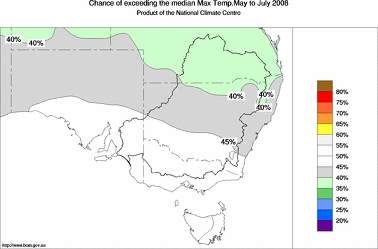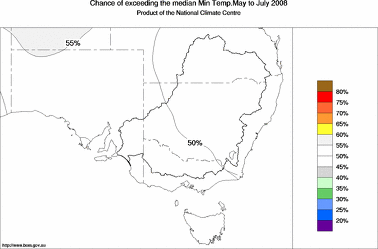|
Averaged over May to July, the chances are close to 50% for above-normal
maximum temperatures in Tasmania, Victoria and southern SA and southern
NSW (see map). So for every ten years with ocean patterns like the current,
about five May to July periods are expected to be warmer than average over these
parts of the country, with about five being cooler.
There is, however, a gradual decrease in the odds of above-normal maximum
temperatures grading to the north, with only about a 40% chance in the far
north of South Australia and over northern NSW. This is consistent with the
rain outlook which favours above average falls in this region.
This pattern of seasonal maximum temperature odds across southeast Australia,
in particular the reduced odds in the north, is mainly a result of the cooler
than average temperatures in the equatorial Pacific associated with the now weakening
La Niña. Indian Ocean temperatures are not having a significant impact on the
odds of warmer or cooler maximum temperatures.
Outlook confidence is related to how consistently the Pacific and Indian
Oceans affect Australian temperatures. During the May to July period, history shows
this effect on maximum temperatures to be strongly consistent over Tasmania, the
southeast districts of SA and most of Victoria, and moderate over the rest of
the southern half of SA, and over southern and inland NSW, apart from the northwest
(see background information). However, confidence levels are low in northern SA and in the northwest
of NSW, and along the coast and adjacent ranges north from Sydney, so this
outlook should be used with caution in those areas.
The neutral pattern of seasonal minimum temperature odds for the May to July period
in across southeast Australia (see map) is a result of countering influences from the
cooler than average temperatures in the equatorial Pacific (increasing the odds of
warmer nights in the north while reducing them in the south) and warmer temperatures
in the Indian Ocean near Australia (decreasing the odds in the north and increasing
them in the south) producing an overall neutral outlook for minimum temperatures.
History shows the oceans' effect on minimum temperatures in the May to July period
to be moderately to strongly consistent over northern and especially northeastern
NSW, and moderately consistent over the remainder of NSW (apart from the southwest)
and over Tasmania and parts of coastal Victoria and South Australia. Elsewhere the
effect is only weakly or very weakly consistent.
| 










